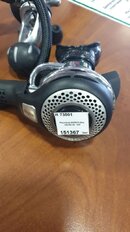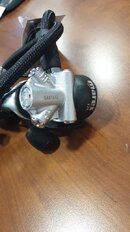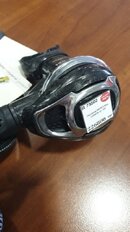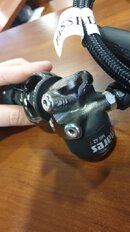You are using an out of date browser. It may not display this or other websites correctly.
You should upgrade or use an alternative browser.
You should upgrade or use an alternative browser.
Mares regulator, keep or exchange...
- Thread starter Anar
- Start date
Please register or login
Welcome to ScubaBoard, the world's largest scuba diving community. Registration is not required to read the forums, but we encourage you to join. Joining has its benefits and enables you to participate in the discussions.
Benefits of registering include
- Ability to post and comment on topics and discussions.
- A Free photo gallery to share your dive photos with the world.
- You can make this box go away
You got me thinking again, the model that they have looks new, its Abyss 22X.
Here is the picture:


What do you think?
Also turns out they have a Mares Carbon 42T:


It is discounted, and the price is almost the same as for Abyss. I remember you mentioned that 42 might be hard to services, but just in case what do you think of the model.
Here is the picture:


What do you think?
Also turns out they have a Mares Carbon 42T:


It is discounted, and the price is almost the same as for Abyss. I remember you mentioned that 42 might be hard to services, but just in case what do you think of the model.
The guide like this would be very useful. Looking forward to reading it!Proton Metal seconds don't have any unusual issues. Well, the bypass/VAD design means Mares seconds don't need a dive/pre-dive switch (although a few models have them for marketing purposes) and high-performance regs without a pre-dive switch (or with one that is set to dive) will freeflow if you fully dunk them cover first. They will stop as soon as you turn the mouthpiece down and can be avoided by entering the water in with the mouthpiece in your mouth or by holding the mouthpiece down.
Note that Mares regs sold as octos are detuned a little bit to avoid this. That and the color are the only difference between a Mares reg sold as a primary and as an octo. Personally, I prefer to have my octo tuned to primary specs and try to remember to orient it correctly on entry.
I've been working on a little guide to Mares regs of the last 20 years which might be helpful to the OP. I think I'll have it posted this weekend.
You got me thinking again, the model that they have looks new, its Abyss 22X.
Here is the picture:
View attachment 573748 View attachment 573749
What do you think?
Also turns out they have a Mares Carbon 42T:
View attachment 573750 View attachment 573751
It is discounted, and the price is almost the same as for Abyss. I remember you mentioned that 42 might be hard to services, but just in case what do you think of the model.
At $200 plus trade for the MR22 and Abyss 2nd stage you have depicted that is not a bad deal. It would be an even better deal if you could buy it for $200 and just keep the MR12 and Proton metal setup....that way you would be able to run double tanks, or a single tank with double outlet valve (H or Y type), this would be good if you plan to dive in water below 10c. It would also preclude your need to buy an octo as you could move the Proton metal 2nd stage to the MR22 and use it as your octo. The only addition you would need is an spg on a high pressure hose.
I would recommend staying away from the MR42. The T just means that it uses the T-type high pressure poppet that they have been using for quite a number of years. For history purposes before the T type high pressure poppet they had what they called the "spherical conic seat". Parts for the SCS system are increasingly harder to find, though Mares 1st stages with removable HP seats like later models of the MR22 could be converted to use the T type poppet....
.....I digress....the concern with the MR42 is that it was basically a scaled down version of the MR22 targeted, from my understanding, at the travel market. The scaled down version was lighter in weight so less impact on baggage weight allowance. The problem is that they made specific parts for some of the internal parts of the MR42, and since it is has been out of production for a bunch of years support by way of spare parts are/will be increasingly harder to find. The MR22 is still in production as the MR22 Navy III. The standard MR22 was removed from the Mares line-up about a year or so ago. It is my understanding that the high pressure T style poppet along with the high pressure seat used in the MR22 is common across Mares diaphragm 1st stages that have been in production for the last handful of years....the exception being the MR12 and the MR42. For further accuracy, Mares switched to a more durable material for the sealing surface of the T type poppet for their diaphragm regulators but because of US Navy certifications of the MR22 Navy model they are still using the tri-material T type poppet in the MR22 Navy model of the 1st stage.
Here are is summary of my recommendations to help you clarify the decisions...I don't believe you would be making a mistake following any of the following courses of action, but that is ultimately something you need to decide:
1. Stay away from the MR42
2. Keep your MR12 + Pronton metal setup and happily dive with it
3. Keep your MR12 + Proton metal setup and purchase the MR22 + Abyss setup for as close to $200 as you can, and then dive happily with them.
4. Trade in the MR12 + Proton metal setup and purchase the MR22 + Abyss setup for $200.
-Z
Kinda on topic what about the 52x? Seems there is a lot of mares people in here.
The MR52 is essentially a MR22 with a different external form factor and 2 LP ports designated as DFC.
MR22:
1 x 1/2" threaded LP port for the primary 2nd stage hose to connect, this is the DFC port
3 x 3/8" LP ports.
2 x 7/16" HP ports (angled downward at @ 45 degree to the 1st stage body)
MR52:
4 x 3/8" LP ports (current industry standard for LP port size), 2 of which are designated DFC
2 x 7/16" HP ports, angled but not as much as the on the MR22.
The 2 DFC port design is supposedly to give the owner more options for routing the primary 2nd stage hose.
The 52 was also smaller and lighter than the original MR22 which was a honkin huge piece of machined brass covered in chrome. The 52 had more metal machined away on the outside and then plastic pieces were used for aesthetics of the 1st stage body.
The 52 and the 22 use the same service kit.
It is my understanding that the "X" designation of the Mares 1st stage models only indicates the use of the current high pressure poppet design that is considered to have a more durable sealing surface to what they had used previously. Therefore the MR52 used the Tri-material poppet design and the MR52X uses the current poppet design.
The MR52 also came in a version with M26x2 DIN fitting for use high O2 content mixes.
Hope that helps.
-Z
At $200 plus trade for the MR22 and Abyss 2nd stage you have depicted that is not a bad deal. It would be an even better deal if you could buy it for $200 and just keep the MR12 and Proton metal setup....that way you would be able to run double tanks, or a single tank with double outlet valve (H or Y type), this would be good if you plan to dive in water below 10c. It would also preclude your need to buy an octo as you could move the Proton metal 2nd stage to the MR22 and use it as your octo. The only addition you would need is an spg on a high pressure hose.
I would recommend staying away from the MR42. The T just means that it uses the T-type high pressure poppet that they have been using for quite a number of years. For history purposes before the T type high pressure poppet they had what they called the "spherical conic seat". Parts for the SCS system are increasingly harder to find, though Mares 1st stages with removable HP seats like later models of the MR22 could be converted to use the T type poppet....
.....I digress....the concern with the MR42 is that it was basically a scaled down version of the MR22 targeted, from my understanding, at the travel market. The scaled down version was lighter in weight so less impact on baggage weight allowance. The problem is that they made specific parts for some of the internal parts of the MR42, and since it is has been out of production for a bunch of years support by way of spare parts are/will be increasingly harder to find. The MR22 is still in production as the MR22 Navy III. The standard MR22 was removed from the Mares line-up about a year or so ago. It is my understanding that the high pressure T style poppet along with the high pressure seat used in the MR22 is common across Mares diaphragm 1st stages that have been in production for the last handful of years....the exception being the MR12 and the MR42. For further accuracy, Mares switched to a more durable material for the sealing surface of the T type poppet for their diaphragm regulators but because of US Navy certifications of the MR22 Navy model they are still using the tri-material T type poppet in the MR22 Navy model of the 1st stage.
Here are is summary of my recommendations to help you clarify the decisions...I don't believe you would be making a mistake following any of the following courses of action, but that is ultimately something you need to decide:
1. Stay away from the MR42
2. Keep your MR12 + Pronton metal setup and happily dive with it
3. Keep your MR12 + Proton metal setup and purchase the MR22 + Abyss setup for as close to $200 as you can, and then dive happily with them.
4. Trade in the MR12 + Proton metal setup and purchase the MR22 + Abyss setup for $200.
-Z
Thank you, Zef,
They are actually willing to give me a bit of a discount, so it'll be a bit cheaper.
I am still getting used to the idea of owning a regulator, so I think, I'll keep one for now)
I was wondering what does X mean in Abyss 22X (you can see it in the picture of 1st stage). Is it some kind of different type of high pressure poppet as opposed to 12T, 42T?
It is the latest version of Abyss 22 models, isnt it?
Thank you, Zef,
They are actually willing to give me a bit of a discount, so it'll be a bit cheaper.
I am still getting used to the idea of owning a regulator, so I think, I'll keep one for now)
I was wondering what does X mean in Abyss 22X (you can see it in the picture of 1st stage). Is it some kind of different type of high pressure poppet as opposed to 12T, 42T?
It is the latest version of Abyss 22 models, isnt it?
The "X", as far as I know indicates the current more durable sealing surface of the high pressure poppet in the 1st stage. It is the latest design for Mares diaphragm 1st stages.
The "T" indicated either the change from the SCS poppet design to the "T" style poppet design or it meant the "Tri-material" design of the T shaped poppet. The current poppet design is still the T shape form factor just the sealing surface has changed.
-Z
Yes, the X indicates the change from Tri-material poppet to ACT poppet. Unless a shop is still using up old parts inventory, a T will become an X at the first overhaul anyway, as that part is always replaced during overhaul. Exceptions are the 42 series which is a smaller poppet and no ACT/X version exists, and the Navy that continues to use the older version.The "X", as far as I know indicates the current more durable sealing surface of the high pressure poppet in the 1st stage. It is the latest design for Mares diaphragm 1st stages.
The "T" indicated either the change from the SCS poppet design to the "T" style poppet design or it meant the "Tri-material" design of the T shaped poppet. The current poppet design is still the T shape form factor just the sealing surface has changed.
-Z
Zef pretty much nails it.
A couple of minor points.
The 12, 15, 22 and 52 (and older 16 and 32) balanced diaphragm first stages all use the same internal service parts. They will be available forever. Only the 42 has its own unique parts.
The only difference between the MRxxT and xxX (e.g. MR22T and 22X) versions is an upgraded sealing material on the face of the poppet. The newer (after 2015) "ACT" poppet on the X versions is a straight swap for the "tri-material" poppet on the T versions. It will get upgraded at the next service or if there is a problem. The tri-material seal actually works quite well and was itself an upgrade over both the original poppet seal and SCS seal of the late 90s and early 00s.
For historical context, first stages with the SCS seals had a V prefix. Note that all first stages except the 42 (and some really old versions of the MR12 with a single HP port that had a non-replaceable seat) can be upgraded to the current sealing system by swapping in a new poppet or poppet and a new seat.
A couple of minor points.
The 12, 15, 22 and 52 (and older 16 and 32) balanced diaphragm first stages all use the same internal service parts. They will be available forever. Only the 42 has its own unique parts.
The only difference between the MRxxT and xxX (e.g. MR22T and 22X) versions is an upgraded sealing material on the face of the poppet. The newer (after 2015) "ACT" poppet on the X versions is a straight swap for the "tri-material" poppet on the T versions. It will get upgraded at the next service or if there is a problem. The tri-material seal actually works quite well and was itself an upgrade over both the original poppet seal and SCS seal of the late 90s and early 00s.
For historical context, first stages with the SCS seals had a V prefix. Note that all first stages except the 42 (and some really old versions of the MR12 with a single HP port that had a non-replaceable seat) can be upgraded to the current sealing system by swapping in a new poppet or poppet and a new seat.
Jack posted while I was writing my reply. He's a dive shop owner and Mares service technician. I'm glad to see that we agree 
By the way, that Carbon 42T is a neat setup for a travel reg for the dedicated Mares fan who is willing to take a chance on future parts availability for the first stage (the Carbon second is still in production and uses standard Abyss service parts so no problem there). You'll certainly be the only diver on your block to own one.
By the way, that Carbon 42T is a neat setup for a travel reg for the dedicated Mares fan who is willing to take a chance on future parts availability for the first stage (the Carbon second is still in production and uses standard Abyss service parts so no problem there). You'll certainly be the only diver on your block to own one.
Similar threads
- Replies
- 8
- Views
- 411
- Replies
- 0
- Views
- 241
- Replies
- 21
- Views
- 2,714



